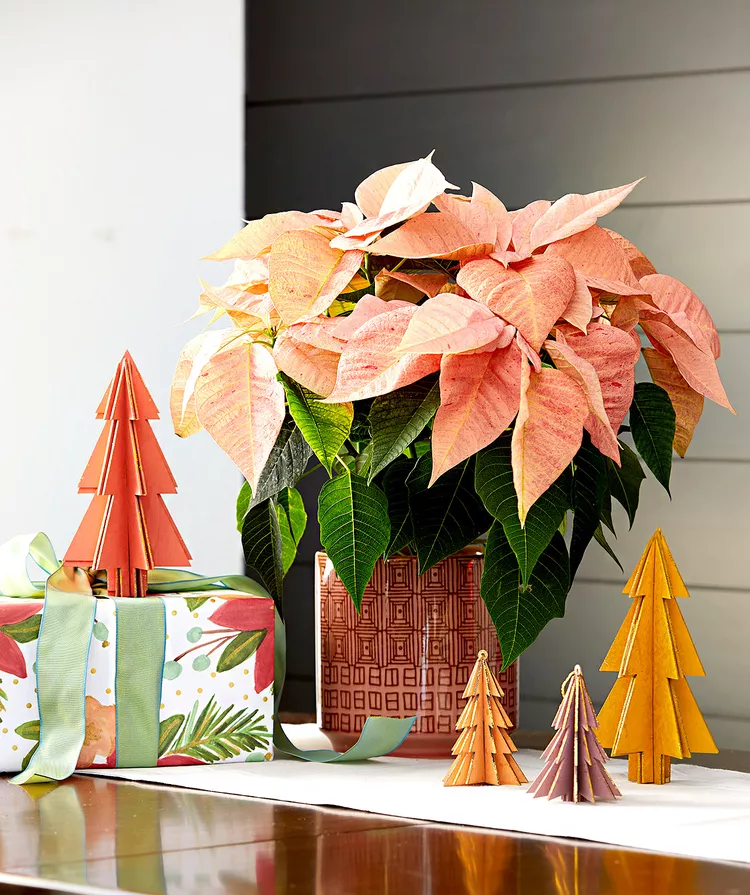Poinsettias wrapped in shiny foil brighten the holidays with red, creamy white, pink, or bicolor blooms. Some even have flowers spray-painted in colors like blue and purple and glitter-bombed for some extra sparkle. But the colorful parts of this plant aren't flowers. They're bracts (modified leaves). The actual flowers are the small green or yellow parts in the center of the bracts. While spray-painted poinsettias don't usually last as long as the natural ones, these plants all do best with a little TLC. In return, they'll reward you with their festive colors well into the New Year. Start with avoiding these 7 poinsettia care mistakes that people most often make.
1. Exposure to the Freezing Cold
Poinsettias are grown in greenhouses to color up in time for the holidays. Then they're shipped off to sell. You can purchase them in greenhouse pots or in arrangements or planters (like this Better Homes & Gardens 8-inch Poinsettia Live Plant with Ceramic Vase, $33, Walmart). When we take a pampered plant from a warm store through a cold parking lot to the car, it can start to lose its leaves from the shock of temperature change. Protect your plant with a bag or paper if it's going to be outside in cold weather for more than a few minutes.
2. Keeping Your Plant in a Room That's Too Hot or Cold
Indoor temperatures on the cooler side are fine, says Gary Vollmer, poinsettia product manager for Selecta One. "While outside winter temps will kill a poinsettia, indoor temperatures from 55°F to 75°F are fine." Keep plants away from cold drafts near doors and windows and heat from vents, radiators, and fireplaces.
3. Not Providing the Right Amount of Light
"Poinsettias in the home are living plants and need some light to thrive," Vollmer says. "Keeping the plant in a bright location will do wonders to keep it going." However, poinsettias can burn in direct sunlight, so give them a brightly lit spot where the sun can't shine right on them.
4. Overwatering Your Poinsettia
Pots without drainage holes can leave poinsettia roots sitting in water. This can make the leaves turn yellow and drop, or the roots can rot, and the entire plant can die. To avoid this problem, make a few holes in your container, or move your plant into a pot that has drainage holes. Try this Better Homes & Gardens White Round Ceramic and Wood Planter and Stand Set ($50, Walmart) to add a stylish touch to your display. If you keep your plant in a saucer or a decorative pot, make sure to pour out any excess water, says Harvey Lang, Ph.D. and senior technical lead for Syngenta Flowers North America. You could also punch a few holes in the bottom of the pot sleeve and use a waterproof saucer or tray underneath to protect your tabletops.
5. Forgetting to Water
This can be as harmful as overwatering, so don't let your poinsettia dry out. Instead, water your plant when the pot feels light, the plant becomes top-heavy, or the soil feels dry to the touch, says Vollmer. The soil should stay moist but not soggy.
6. Fertilizing at the Wrong Time
Barbara Pierson, nursery manager for White Flower Farm, says you don't need to feed your plants while they're blooming. Poinsettia colors often start to fade by February. If you want to keep your plant for its green leaves or coax it to rebloom, wait until May to begin fertilizing. Follow the directions on your product label.
7. Feeling Stressed About Keeping Poinsettias Alive After the Holidays
Poinsettias are grown in greenhouses with the right lighting, temperatures, and care so they'll look beautiful and tempting in stores, says Lang of Syngenta Flowers. That's why it's challenging to get your plant to bloom again. Save yourself the stress of trying to keep your poinsettia alive and compost your tired plant after the holidays. Then, treat yourself to a fresh poinsettia next year.




















